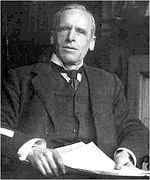Ernest Starling
| Ernest Starling | |
|---|---|
 Ernest Starling | |
| Born |
17 April 1866 London |
| Died |
2 May 1927 (aged 61) Kingston Harbour, Jamaica |
| Nationality | English |
| Fields | Physiology |
| Institutions | University College London |
| Known for | Frank–Starling law of the heart |
Ernest Henry Starling (17 April 1866 – 2 May 1927) was an English physiologist.[1] He worked mainly at University College London, although he also worked for many years in Germany and France. His main collaborator in London was his brother-in-law, Sir William Maddock Bayliss.[2]
Starling is most famous for developing the "Frank–Starling law of the heart", presented in 1915 and modified in 1919. He is also known for his involvement along with Bayliss in the Brown Dog affair, a controversy relating to vivisection. In 1891, when he was 25, Starling married Florence Amelia Wooldridge, the widow of Leonard Charles Wooldridge, who had been his physiology teacher at Guy's and died at the age of 32. She was a great support to Starling as a sounding board, secretary, and manager of his affairs as well as mother of their four children.
Other major contributions to physiology were:
- The Starling equation, describing fluid shifts in the body (1896)
- The discovery of peristalsis, with Bayliss
- The discovery of secretin, the first hormone, with Bayliss (1902) and the introduction of the concept of hormones (1905)
- The discovery that the distal convoluted tubule of the kidney reabsorbs water and various electrolytes
Starling was elected fellow of the Royal Society in 1899.
Two of his great-grandchildren, Boris Starling (b. 1969) and Belinda Starling (1972–2006) are writers.
Death
Starling died in 1927 during a sea voyage to the Caribbean, and was buried in Kingston, Jamaica on 4 May of that year.[3]
References
- ↑ Henderson, John (2005), A Life of Ernest Starling, Oxford University Press
- ↑ "Ernest Henry Starling". Whonamedit.com. Retrieved 24 November 2007.
- ↑ Henderson, John (2005), A life of Ernest Starling, New York: Published for the American Physiological Society by Oxford University Press, ISBN 978-0-19-517780-0
- Fye, W Bruce (2006), "Ernest Henry Starling", Clinical cardiology (Apr 2006) 29 (4): 181–182, doi:10.1002/clc.4960290413, PMID 16649731
- Henriksen, Jens H (2005), "Ernest Henry Starling (1866–1927): the scientist and the man", Journal of medical biography (Feb 2005) 13 (1): 22–30, PMID 15682229
- Katz, Arnold M (2004), "Ernest Henry Starling: medical educator", The Pharos of Alpha Omega Alpha-Honor Medical Society. Alpha Omega Alpha 67 (4): 14–21, PMID 15625946
- Katz, Arnold M (2002), "Ernest Henry Starling, his predecessors, and the "Law of the Heart"", Circulation (3 Dec 2002) 106 (23): 2986–2992, doi:10.1161/01.CIR.0000040594.96123.55, PMID 12460884
- Tucci, P J (1992), "[Ernest Henry Starling—the scientist, the educator, and the fundamental law of the heart]", Arq. Bras. Cardiol. (Apr 1992) 58 (4): 296–302, PMID 1340699
- Fye, W B (1983), "Ernest Henry Starling, his law and its growing significance in the practice of medicine", Circulation (Nov 1983) 68 (5): 1145–1148, doi:10.1161/01.CIR.68.5.1145, PMID 6352082
- "Ernest Henry Starling (1866–1927)", Triangle; the Sandoz journal of medical science 7 (5), 1966: 165, ISSN 0041-2597, PMID 5328520 More than one of
|periodical=and|journal=specified (help) - BEAN, W B (1963), "Ernest Henry STARLING, the clinican's physiologist, with an aside on wandering navels", Arch. Intern. Med. (Apr 1963) 111: 403–5, PMID 13969932
|